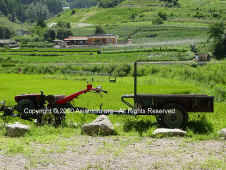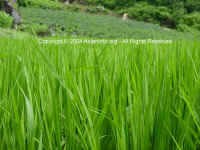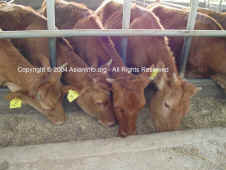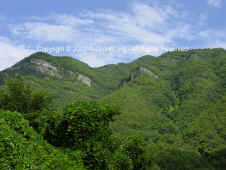|
Agriculture and Forestry in
Korea

Agriculture
Although the agriculture industry has grown at a steady rate,
its share in the national economy has decreased due to a lower growth rate.
In 1997, the average farm size continued to be slightly more
than one hectare. Major crops include rice, fruits and vegetables. The livestock
industry is composed of beef and dairy cattle, hog and chicken. Since the Korean
diet has turned to protein-based foods, such as meat which require imports of
feed grains, the self-sufficiency ratio has been quite low. For example, the
self-sufficiency ratio of cereals in 1997 was about 30 percent.
After the establishment of the World Trade Organization
(WTO),
the agricultural policy basically aimed to enhance the market competitiveness of
Korean agricultural commodities. Following the financial crisis of 1997,
economic adjustment programs, initiated by the International Monetary Fund (IMF)
bailout loan, put a strain on agricultural investments. As a result, many
farming units with large loans are suffering from cost increases and debt
burdens.
Back to Top...

Rice Production
Korean agriculture and agricultural policies are centered on
rice. Rice is often considered a political commodity, since it is a staple food
and about 80 percent of all farms cultivate rice. The maintenance of high
self-sufficiency ratio of rice has always been an important policy objective in
modern Korean history.
Korea produces most of its domestic consumption of rice. The
Uruguay Round Agreement requires the implementation of a minimum market access
of 1 to 4 percent of the total consumption of rice in the period between
1995-2004. Except for the required portion of importation, the government tries
to supply domestic need through domestic production.
Cultivated areas for rice increased gradually from 1970 to
1990 and then declined to 1,052,000 hectares in 1997. However, due to the
increase in yields per hectare, the rice production on average has not decreased
substantially. In 1996 and 1997, there were good harvests of rice with record
high yields. The rice yield per hectare reached 5.18 tons in 1997.
Recent policy programs for rice are focused on improving
market competitiveness. Based upon the Competitiveness Enhancement Programs in
1994 and the Comprehensive Program for Rice Industry Promotion in 1996, rice
policies aim at more market-oriented programs by allowing larger seasonal
fluctuations in price.
Back to Top...
Production of Wheat, Barley and Other Crops
The production of barley, wheat, soybean and other crops has
continuously decreased due to relatively lower profitability and the labor
constraints hindering double cropping of the paddy fields. Korea meets most of
its demand for wheat, soybean and feed grains through imports from the
international market.
The production of barley and wheat declined from 299,000 tons
in 1996 to 195,000 tons in 1997. Soybean and potato production also decreased
slightly in 1997, amounting to 182,000 tons and 218,000 tons, respectively.
Between 1965 and 1996, per-hectare yields of barley increased from 1.7 tons to
2.6 tons. In the same period, soybean and corn yields have shown remarkable
increases, from 0.57 tons and 0.81 tons to 1.63 tons and 4.03 tons,
respectively.
Back to Top...
Fruits Production
The 1997 total fruits production was slightly larger than
1996. Pear, peach, mandarin and grape production is increasing. By contrast,
apple production is on a decreasing trend because of relatively low
profitability. Unlike other fruits, areas planted for apple are rapidly
decreasing.
Fruit farming in Korea is characterized by small-scale land
area per orchard. Eighty-six percent of the total fruits farms have less than 1
hectare of land. Most of the orchards are geographically scattered and subject
to part-time operation, mixed with other crops, such as rice and other
businesses.
The Kyongsangbuk-do province
produces about 70 percent of Korea's apples. Pear production is scattered
throughout Kyonggi-do, Kyongsangnam-do
and Ch'ungch'uongnam-do provinces. About 50 percent
of grape is produced in Kyongsangbuk-do province.
Mandarin is exclusively produced in Cheju-do province, the largest island in
Korea.
Korea exports fruits to other countries. About 3,500 tons of
pears and 4,600 tons of apples were exported in 1997. Major export markets for
pears are the United States, Taiwan and Indonesia. Apples are exported to
Taiwan, Singapore and Thailand. About 3,000 tons of mandarins are exported to
the United States and Canada.
About 9 million tons of vegetables were produced in 1997,
slightly down from the previous year. Korea maintains self-sufficiency in most
of vegetable products. Among them, Chinese cabbage and radish are important
items since they are main ingredients for kimchi-the Korean style pickled
side dish. Other vegetables include red pepper, garlic and onion. The production
of garlic and onion shows substantial fluctuations each year.
The share of vegetables in total agricultural production has
been on the increase. Increasing vegetables production is driven by higher
incomes and consumer demand. It reached the peak of 24.4 percent of the total
production in 1995 and has been declining since ever. The vegetable production
in glass houses are on the increase. Watermelon and cucumber are the major crops
grown in house facilities.
Back to Top...

Livestock
The livestock industry is one of the most dynamic sectors of
Korea's agriculture industry. With the rapid growth of the economy, consumption
of meat and dairy products has increased rapidly. Since Korea depends on imports
for feed grains, livestock herding is deeply influenced by the international
market situation and the foreign exchange rates.
Meat production has continuously increased, largely in
response to the increased consumption and government support. The total beef
production in 1997 was 237,000 tons, substantially up from 174,000 tons in 1996.
In 1997, pork production was 699,000 tons; chicken production, 279,000 tons; the
total milk production, 2,093,000 tons. The production of pork, chicken and milk
in 1997 was about the same as the year before.
The total head count of cattle raised in 1997 was 3,279,000, a
0.3 percent decrease from the previous year. With a total of 465,000 farm
household engaged in raising cattle, the average herding size was 5.9 head. The
total cattle head consists of 2,735,000 of Korean beef cattle and 544,000 dairy
cattle. Hogs and chickens raised in 1997 were 7,096,000 and 88,251,000,
respectively.
Beef consumption has shown a steady increase with rising
income. Beef consumption in 1997 was 362,000 tons, up 12.1 percent from 1996.
Beef consumption in 1985 and 1990 was 120,000 tons and 177,000 tons,
respectively. The total pork and chicken consumption in 1997 was 698,000 tons
and 279,000 tons, respectively. These consumption levels have been about the
same for the last three years. Milk consumption in 1997 was 2,440,000 tons.
Korea imports beef and milk, and maintains self-sufficiency in chicken. Korea
exports pork to Japan.
Back to Top...
Agricultural Adjustment
After the conclusion of the Uruguay Round negotiations, the
Korean government launched the Agricultural and Fisheries Development Program in
1994. The program focused on three major objectives: to strengthen the
competitiveness of Korean agriculture, to develop rural communities and to build
comfortable rural living conditions.
The government has been committed to implementing "the
Agreement on Agriculture," which was launched between 1995 and 2004 in
accordance with the Uruguay Round negotiations. This agreement requires Korea to
open its agricultural markets and reduce its domestic support for farming. The
government has increased investments to the agricultural sector with policy
measures allowed in the agreement. With large investment and institutional
reforms in the agricultural sector, the agricultural structure in Korea has been
steadily changing.
The recent economic crisis and the International Monetary Fund
(IMF)-initiated reform programs have brought about a different policy
environment. The tight budget restricts investment in agriculture, production
costs, especially related to imported resources such as energy and feed grains,
are increasing. A decreased demand for agricultural products is resulting in
weak prices. In order to overcome these difficulties, the government is
currently working out a new agricultural development program.
Back to Top...

Forestry
As of 1996, South Korea's forest land contributed roughly 6.5
million hectares, representing 65% of the total landmass area. However, the
forest land per capita is only 0.15 hectares, only 20% of the world's average.
Forest lands are classified into national, public, and private forests. These
include reserve forests for production and public welfare use and semi-reserve
forests for industrial use. National forests which are managed by the central
government comprise about 21% of the total forest area in South Korea. Public
forests owned by the local government comprise about 8%; the rest is privately
owned.
The total stock volume stands at 324 million cubic meters, and
the average stock volume per hectare in 1996 is estimated at 50 cubic meters.
The most representative forest in Korea is the coniferous forest. Coniferous
forests account for 46% of the total forest land, while the broad-leaved, mixed
and other forests constitute 26% and 27%, respectively. The major tree species
of Korea's forests are the red pine, the Korean white pine, larch and oak
species.
Back to Top...
Silviculture and Forest Management
At the end of the Korean War in 1953, the average volume of
forest land was less than 10 cubic meters per hectare, and more than 80% of
Korea's forests were devastated. In 1961, the Forest Law was enacted and in
1973, the Forestry Administration embarked upon a 10-year National Forest Basic
Plan. Since that time, the Forest Plan was reenacted three times (1973-78;
1979-87; and 1988-97) with the result that nearly 100% of Korea's damaged
forests are now fully recovered and are even producing commercial yields. The
total reforestation area is 4.0 million hectares, with the number of seedlings
set at about 11,050 million. Apart from these planting zones, the remaining area
is about 2.5 million ha, which represents 63% of the total forest area.
The goal of the First Forest Plan, enacted in 1973, was to
embark upon the immediate reforestation of the nearly 1 million ha of
commercial forest. These plans (1973-78; 1979-87), however, were completed
earlier than expected. The Third Plan began in 1988 and was successfully
completed in 1997. The aim of this plan was to achieve a balance between the
economic exploitation of forest lands with their recreational value.
Reforestation and erosion control projects were completed
within a relatively short period. They were based, in large degree, upon the
strong traditional belief that the government is ultimately responsible for the
management of forest and water resources in Korea. Thus, significant investments
in the nation's forests was made since the 1970s as part of the National
Development Plan under President Park Chung Hee. During the 1970s, the
rehabilitation of forest land and forest protection practices played a vital
role in the New Community Movement (Saemaul
Undong). The driving force of these activities was the Forest Association
and its village sub-units called "sallimgye." The Forestry Association
was reformed under the title of Forestry Cooperatives in 1993.
International organizations like the FAO and the WRI have
evaluated Korea's reforestation programs as one of the most successful forest
projects in the world. However, because 80% of Korea's forests are under 30
years old, they are still relatively unproductive. More efforts and resources
are needed to achieve the continued success of forest management in Korea.
Back to Top...
Forest Industry and Products
Since the 1960s, Korea has witnessed a rapid development of
its economy. As such, Koreans have relied heavily on wood products for domestic
use as well as overseas exports. Timber industries had been one of Korea's main
exporting industries in the 1970s. Plywood and Sawnwood industries, for example,
developed rapidly from the late 1960s to the early 1980s. At the same time, they
also played a leading role in the domestic economy by supplying stable sources
of wood products for construction and housing.
In recent years, however, Korea has relied heavily on timber
from overseas due to low domestic productivity. The volume of imported logs was
about 8.3 million cubic meters in 1997, and the total amount of imported forest
products was US$ 2.6 billion. The self-sufficiency ratio of timber was under 5%.
From the 1980s onward, Korean timber industries have declined
rapidly due to restrictions of log exports by tropical countries, the increase
of domestic labor costs and the development of timber substitution technology.
As a result, the large percentage of imported forest products are being used for
domestic consumption.
Korea now imports log and forest products from more than 20
countries. Malaysia, Papua New Guinea, the United States, Chile, and New Zealand
are its main suppliers. To ensure the stable supply of logs, pulp chips, among
other things, private companies have already launched forest projects in New
Zealand, Australia, Vietnam, and China.
Some forest products, however, continue to be exported. The
pine mushroom and chestnut constitute the bulk of Korea's exported forest
products. The pine mushroom, in particular, is well known abroad for its
delightful fragrance and taste. The total amount of exported forest products was
roughly US$ 511 million in 1995, and US$ 340 million in 1997.
Back to Top...
Forest Culture and Outdoor Recreation
During the 1950s, korea was a poor developing nation, its
forest decimated by the havoc wrecked upon it by the Korean War. Since the
1980s, however, it has achieved one of the most successful reforestation
programs within the developing world. Along with Korea's economic growth, its
forest management program can be considered to be one of the barometers that
measure the nation's political maturity. To further encourage these
environmental concerns, as well as to increase the Korean people's understanding
of the necessity of sustainable forests, the government has established a total
of 67 national and public recreational forests as part of its Third Forest Plan.
The total area of recreational forests in Korea is about 117 thousand hectares
and more than 12 million people have visited them since they were established.
The number of visitors has also gradually increased each year. Smaller forests
are also being developed near urban areas.
In the 1950s, Korea underwent a series of dramatic educational
reforms. The 1960s and 1970s marked the nation's economic development which was
soon followed by the revolutionary political changes during the late 1980s and
1990s. Today marks the beginning of the nation's environmental era. The main
goal in this day and age is to improve the quality of daily life by providing
its citizens with clean water, clean air and green forests.
Back to Top...
Information
provided by the Korean Embassy
|
